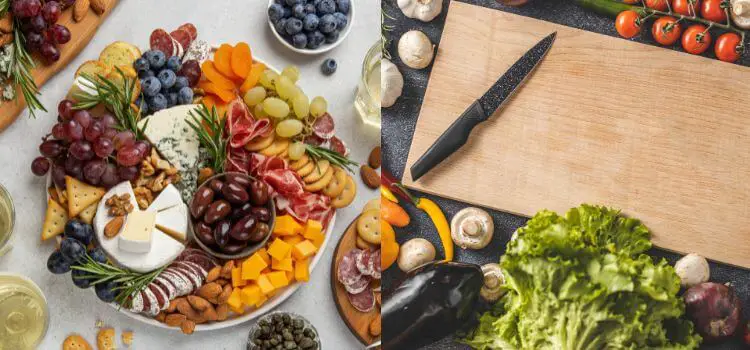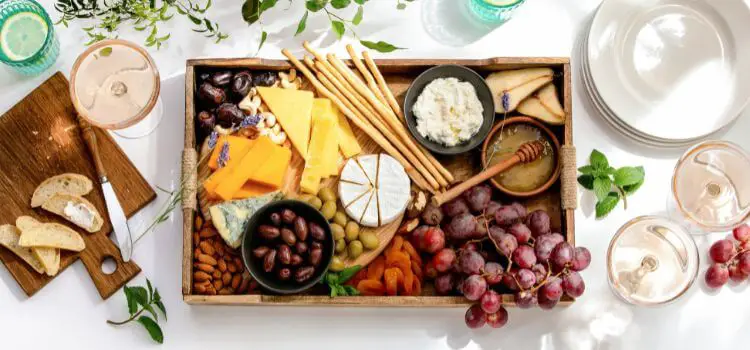As an Amazon Associate, I earn from qualifying purchases

In the world of culinary arts, kitchen tools play a crucial role in both food preparation and presentation. Among these tools, cutting boards and charcuterie boards often take center stage, each serving unique purposes. While they may appear similar at first glance, they cater to different culinary needs.
A cutting board is primarily a utilitarian tool designed for chopping and slicing, while a charcuterie board is an elegant platform for presenting an assortment of meats, cheeses, and accompaniments. This article delves into the distinctions and similarities between these two essential kitchen items.
Purpose and Functionality
At the heart of their differences lies their primary purposes. Cutting boards are indispensable tools for food preparation. Crafted to withstand the repeated impact of knives, they provide a safe surface for slicing, dicing, and chopping a variety of ingredients. Whether you’re cutting vegetables for a stew or filleting a fish, the cutting board is your go-to tool for ensuring efficiency and precision in the kitchen.
In contrast, charcuterie boards are all about food presentation. Originating from the French tradition of preparing and arranging cured meats, charcuterie has evolved to include a variety of foods, such as cheeses, fruits, nuts, and spreads. A charcuterie board is a canvas for culinary artistry, where visual appeal is as important as taste. It allows for a creative display of flavors and textures, often becoming the centerpiece of social dining experiences.
Materials and Construction
The material composition of cutting boards and charcuterie boards greatly influences their functionality and aesthetics. Cutting boards are typically made from wood, plastic, or bamboo. Each material offers distinct advantages: wood is gentle on knives and has natural antibacterial properties, plastic is easy to sanitize, and bamboo is sustainable and durable. These materials are chosen to withstand the rigors of daily kitchen use.
Charcuterie boards, on the other hand, prioritize aesthetics alongside functionality. They are often crafted from materials like wood, slate, or marble. Wood, with its warm tones and natural grains, adds a rustic charm, while slate and marble provide a sleek, modern look. The material choice for charcuterie boards enhances the visual appeal, making them as much a decorative item as a functional one.
Design and Aesthetic Considerations

Design plays a pivotal role in distinguishing cutting boards from charcuterie boards. Cutting boards are designed with a focus on durability and functionality. They often feature juice grooves to contain liquids from meats or fruits, handles for easy maneuverability, and non-slip bases to ensure stability during use.
In contrast, charcuterie boards are designed with aesthetics in mind. They come in a variety of shapes and sizes, from round to rectangular or even uniquely shaped designs. Some feature compartments or sections for organizing different foods, while others are flat surfaces that allow for creative arrangements. The aesthetic appeal of charcuterie boards is crucial, as they often serve as a visual feast before the actual tasting begins.
Appropriate Usage of Each Type
Understanding how to use each type of board appropriately enhances their utility and longevity. For cutting boards, it’s important to use them exclusively for food preparation tasks. To maintain hygiene and prevent cross-contamination, consider using separate boards for different food types, such as one for raw meats and another for vegetables. Regular cleaning with warm, soapy water and periodic oiling of wooden boards will help maintain their condition.
Charcuterie boards, on the other hand, are all about presentation. When arranging a charcuterie board, consider balancing flavors, colors, and textures. Start with larger items like cheeses and meats, then fill gaps with smaller items like nuts and olives. Add height and dimension by stacking or layering elements. To clean, wipe them down with a damp cloth and avoid soaking, especially for wooden boards.
Conclusion
In conclusion, while charcuterie boards and cutting boards may seem similar, they serve distinct roles in the kitchen. Cutting boards are essential tools for food preparation, focusing on durability and functionality. Charcuterie boards, however, are platforms for food presentation, emphasizing aesthetics and creativity.
Understanding their differences and similarities allows you to choose the right board for your culinary needs. Whether you’re preparing a meal or creating a stunning food display, each board has its unique place in the kitchen. Embrace the versatility of these kitchen tools and let them enhance your culinary experiences.
FAQ
What is a charcuterie board considered?
A charcuterie board is considered a decorative serving platter used to artfully display an assortment of cured meats, cheeses, fruits, nuts, and spreads. It focuses on food presentation and enhances the dining experience with its visual appeal, often serving as a centerpiece for gatherings and social events.
What are the 3 types of cutting boards?
The three main types of cutting boards are wood, plastic, and bamboo. Wooden boards are gentle on knives and have natural antibacterial properties. Plastic boards are durable and easy to sanitize, making them ideal for raw meats. Bamboo boards are eco-friendly and known for their hardness and longevity.
What is the difference between a cutting board and a chopping board?
Cutting boards and chopping boards are often used interchangeably, but technically, a chopping board is typically thicker and designed to withstand heavy-duty tasks like chopping large fruits or meats. In contrast, a cutting board is generally thinner and used for slicing and dicing smaller ingredients.
As an Amazon Associate, I earn from qualifying purchases